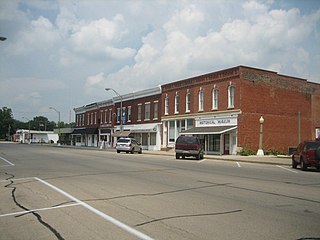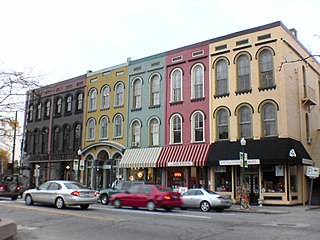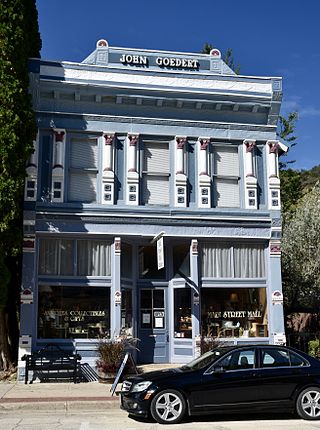
The Main Street Historic District in Tampico, Illinois, United States, is a historic district notable as home to the birthplace of Ronald Reagan. The district includes the late 19th century collection of buildings that comprise Tampico's central business district; among them are two apartments that the Reagan family occupied in the early 1900s. The buildings in the district went through several periods of rebuilding during the 1870s due to major fires and a tornado. The district boundaries encompass the 100 block of Main Street and exclude properties that do not date from the historic period.

The Fort Madison Downtown Commercial Historic District has a collection of late-19th century store fronts centered on Ave. G, from 6th to 9th Street, and Ave. H from 7th to 9th, in Fort Madison, Iowa. It was listed on the National Register of Historic Places in 2007.

The Crescent Warehouse Historic District is a 10.5-acre (4.2 ha) historic district in Downtown Davenport, Iowa, United States. The district is a collection of multi-story brick structures that formerly housed warehouses and factories. Most of the buildings have been converted into loft apartments. The district was listed on the National Register of Historic Places in 2003.

Davenport Bank and Trust Company was the leading bank of the Quad Cities metropolitan area for much of the 20th century and for the surrounding region of eastern Iowa and western Illinois. It was once Iowa's largest commercial bank, and the headquarters building has dominated the city's skyline since it was constructed in 1927 at the corner of Third and Main Streets in downtown Davenport, Iowa. It was acquired by Norwest Bank of Minneapolis in 1993 and now operates as part of Wells Fargo following a 1998 merger of the two financial institutions. The historic building was listed on the National Register of Historic Places in 1983 under the name of its predecessor financial institution American Commercial and Savings Bank. In 2016 the National Register approved a boundary increase with the Davenport Bank and Trust name. It was included as a contributing property in the Davenport Downtown Commercial Historic District in 2020. It remains the tallest building in the Quad Cities, and is today known as Davenport Bank Apartments as it has been redeveloped into a mixed-use facility housing commercial, office, and residential space.

The Hibernia Hall, also known as the Hibernian Hall, is a Romanesque Revival building located in downtown Davenport, Iowa, United States. It is located on the east side of Brady Street, near the middle of the block. The Hibernian Hall was individually listed on the National Register of Historic Places in 1983.In 2020 it was included as contributing property in the Davenport Downtown Commercial Historic District.

City Market is a historic building located in downtown Davenport, Iowa, United States. It was individually listed on the National Register of Historic Places in 1984. In 2020 it was included as a contributing property in the Davenport Downtown Commercial Historic District.

Cody Road Historic District is a nationally recognized historic district located in Le Claire, Iowa, United States. It includes 60 buildings along a nine-block stretch of U.S. Route 67, Cody Road, the primary street through the town. The district contains Le Claire's main commercial district on the south side of the district and residential area on the north. The district has been listed on the National Register of Historic Places since 1979.

The Ypsilanti Historic District is a historic district located along several blocks on each side of the Huron River in the center of Ypsilanti, Michigan. The original portion of the district was designated a Michigan State Historic Site in 1973 and listed on the National Register of Historic Places in 1978; additions to the district were nationally listed in 1989.

The Downtown Commercial Historic District encompasses most of the central business district of Burlington, Iowa, United States. It was listed on the National Register of Historic Places in 2015. The historic district includes 65 properties that were part of a 2012 to 2013 survey of the area. It also includes as contributing properties the buildings in the West Jefferson Street Historic District and three buildings in the Manufacturing and Wholesale Historic District that were previously listed on the National Register. All total there are 122 resources within the district, which includes 108 contributing and 14 non-contributing properties.

The Grant Commercial Historic District is a nationally recognized historic district located in Grant, Iowa, United States. It was listed on the National Register of Historic Places in 2002. At the time of its nomination it contained 17 resources, which included 15 contributing buildings, two contributing structures, and one non-contributing building. The historic district covers the town's central business district. Grant is a small town located in northeast Montgomery County in the southwest quadrant of the state. It was plated in 1858, and it was known as Milford until the early 20th century even though its post office was Grant. While not on a railroad, the town was still able to maintain a viable commercial district.

The Lansing Main Street Historic District is a nationally recognized historic district located in Lansing, Iowa, United States. It was listed on the National Register of Historic Places in 2014. At the time of its nomination the district consisted of 51 resources, including 42 contributing buildings, 8 non-contributing buildings, and one non-contributing site. The district covers most of the central business district, which is generally along Main Street. The commercial buildings are mostly masonry structures constructed with bricks or native limestone. A few buildings are frame construction with gable roofs. The buildings are from one to three stories in height, although most are no taller that two stories. The Italianate architectural style dominates. Most of the upper stories in the buildings housed retail or office space, but a few were residential. The commercial buildings that did not house retail establishments were located near the Mississippi River and were industrial in nature. The G. Kerndt & Brothers Office Block (1861) and the G. Kerndt and Brothers Elevator and Warehouses, No. 11, No.12 and No. 13 (1868) are individually listed on the National Register. Three public buildings are located in the district: the former jail and fire station, the Art Deco former City Hall (1938), and the modern U.S. Post Office.

The Joseph "Diamond Jo" Reynolds Office Building and House is a historic building located in McGregor, Iowa, United States. Joseph "Diamond Joe" Reynolds was a New York native who started working in a gristmill in the 1840s. As the grain belt moved to the west, he moved with it, settling in Chicago in the 1850s and McGregor around 1860. Because of difficulties accessing steamboats to ship grain down the Mississippi River, he established the Diamond Jo line in 1866. It grew to become a major player in the transportation industry. He had its headquarters moved from Fulton, Illinois to Dubuque, Iowa in 1874. By the late 1870s railroads had taken over as the primary means of shipping grain, and Reynolds turned his attention to passenger boats. He had this combination office and residential building constructed in 1885. Reynolds died in 1891 and his widow sold the building before her death in 1895. It has subsequently housed grain trader offices, a billiard parlor, the post office, a winery, shops, and apartments.

The American House, also known as the American Hotel, Evans Hotel, and Ryan House, is a historic building located in McGregor, Iowa, United States. Ohio native William H. Harding had the three-story structure built in 1854. It is a stone building that is covered with a brick veneer on the upper two floors. McGregor was a river port that immigrants used to get to western Iowa, southern Minnesota and points west. In the early years most people came to town via ferry or packet boats on the Mississippi River. They would leave by horse, stagecoach, wagon or train. The stagecoach departed from in front of the hotel. The ticket office for the railroad, which was located across Main Street, was established in the hotel lobby. An addition was constructed on the southwest side of the original building. The sunrooms were built above it in the 1970s and 1980s. The building was individually listed on the National Register of Historic Places in 2001. In 2002 it was listed as a contributing property in the McGregor Commercial Historic District.

The Goedert Meat Market, also known as the Main Street Mall, is a historic building located in McGregor, Iowa, United States. The two-story, single-unit, brick building was completed in 1890 in the Italianate style. It maintains the only complete cast-iron storefront in town. The storefront was manufactured by Mesker Bros. Front Builders of St. Louis, Missouri. The facility dates from the time when all aspects of the meat business from slaughter, to processing, to sales were housed in one building. The New York–style meat market was built for John Goedert, who maintained his residence upstairs. By the turn of the 20th-century it housed Bergman's deli/butcher shop, and remained a butcher shop until 1944. The building was individually listed on the National Register of Historic Places (NRHP) in 1996. In 2002 it was listed as a contributing property in the McGregor Commercial Historic District.
The American School of Wild Life Protection Historic District is a nationally recognized historic district located on the north side of McGregor, Iowa, United States. It was listed on the National Register of Historic Places in 1991. At the time of its nomination the district consisted of 30 resources, including 17 contributing buildings, one contributing site, one contributing structure, nine noncontributing buildings, two noncontributing sites. The American School of Wild Life Protection was established in 1919 in a resort area known as McGregor Heights. The purpose of the school was to promote resource conservation values among the public. It grew out legislation in 1918 that established state parks in Iowa. The school also promoted the idea of establishing a national park in the Upper Mississippi River Valley, and after that did not come about, the Upper Mississippi River National Wildlife and Fish Refuge. The school continued in existence until 1941.

The Cedar Rapids Central Business District Commercial Historic District is a nationally recognized historic district located in Cedar Rapids, Iowa, United States. It was listed on the National Register of Historic Places in 2015. At the time of its nomination it consisted of 60 resources, which included 46 contributing buildings, one contributing structure, 12 non-contributing buildings, and one non-contributing structure. Cedar Rapids was platted on the east bank of the Cedar River as Rapids City in 1841, and it was incorporated under the same name in 1849. Kingston was established on the west bank of the river in 1852. The two smaller communities consolidated in 1870 as Cedar Rapids. The streets were laid out parallel and perpendicular to the river, which flowed from the northwest to the southeast. The Chicago, Iowa and Nebraska Railroad was the first to arrive in the community in 1859 and the tracks were laid on Fourth Street on the eastern edge of the central business district. The first bridge across the river was built at Third Avenue in 1871.

Eagar Townsite Historic District is a section of the town of Eagar, Arizona which has been designated a National Historic Place. Sitting on roughly 54 acres, the site contains 37 structures, 21 of which have historical significance. The period of significance is from 1886, the year the townsite was founded, through 1942, which represents the significant period of development of the town. The site was added to the Register on July 23, 1993.

The Corning Commercial Historic District is a nationally recognized historic district located in Corning, Iowa, United States. It was listed on the National Register of Historic Places in 2012. At the time of its nomination the district consisted of 78 resources, including 56 contributing buildings, one contributing site, one contributing object, 18 non-contributing buildings, and one non-contributing structure. The district covers most of the central business district. It has a linear layout, with twin main streets, associated with Central Park and the Adams County Courthouse at its uppermost end. This is an unusual town layout and is thought to be the only town in Iowa so configured. The elevation slopes down toward the East Nodaway River, south of the downtown and a light industrial area.

The Colfax Spring City Commercial Historic District is a nationally recognized historic district located in Colfax, Iowa, United States. It was listed on the National Register of Historic Places in 2018. At the time of its nomination it contained 48 resources, which included 28 contributing buildings, two contributing sites, two contributing structures, 12 non-contributing buildings, and four non-contributing structures. Colfax was platted in 1866 or 1867 as a railroad and farm-to-market town along the Chicago, Rock Island and Pacific Railroad. Coal mines were also located to the south of town. Mineral water was discovered in the area in 1875, which led to the development of the mineral water-based health industry in Colfax. The historic district represents the growth during this time period. After the health-related mineral water industry declined, Colfax expanded its farm-to-market economy in the late inter-war and post-World War II years.

The Davenport Downtown Commercial Historic District is a nationally recognized historic district located in the central business district of Davenport, Iowa, United States. It was listed on the National Register of Historic Places in 2020. At the time of its nomination it consisted of 43 resources, which included 33 contributing buildings, one contributing structure, and nine non-contributing buildings. In addition, the district also contains 33 buildings that are individually listed on the National Register. This historic district is bordered by four other districts: the Crescent Warehouse Historic District and the Davenport Motor Row and Industrial Historic District on the east, the Hamburg Historic District to the northwest, and the West Third Street Historic District on the west.






















